Learn about the siege of Alexandria, from Julius Caesar's perspective.

Among the collection of writings attributed to Julius Caesar are his descriptions of the siege of Alexandria, the "Gallic Wars" and the "Commentaries on the Civil War".
These archives contain information on different campaigns: the Wars of Alexandria, Africa and Spain. Each of them recount Caesar's military activity from 58 BCE to 45 BCE.
Though Caesar's documents remain a main source of information, it's important to note that the perspective is limited. It is necessary for other historical documents to be taken into consideration to provide a better understanding of events.
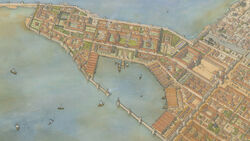
The siege of Alexandria closely relays the events of the Civil War that lead up to the event, and describes how Caesar was besieged in the palace of the Ptolemies.
other ancient authors have left equally valuable, and sometimes contradictory, information.
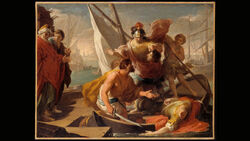
In the events leading up to the siege of Alexandria, Cleopatra VII and her brother were fighting over control of Egypt. Young king Ptolemy XIII's regent, Potheinos had firm control over the young pharaoh, and an oumaneuvered Cleopatra soon went into hiding.
This set the stage for Pompey's arrival in Alexandria. Having lost his battle against Caesar in 48 BCE, the Roman general turned to his allies the Egyptians for safe harbor.
But, on the advice of Potheinos, Ptolemy XIII had Pompey assassinated in the hopes of earning Caesar's favor.

Upon his arrival in Alexandria, Caesar was presented with Pompey's head. The sight of a Roman murdered by Egyptians did not sit well with him.
Caesar made his displeasure clear, ordering the return of Cleopatra, and for the siblings to resolve their differences and resume their co-rule of Egypt, as per the will of their father.
Neither Potheinos nor Potlemy XIII wished to accede to this demand. While doing his best to ggravate Caesar, Potheinos secretly plotted against the Roman ruler, and sent word for Egyptian general Achillas to bring his 20 000 men to fight on his behalf.
While Potheinos plotted against Caesar, Cleoptra made a bold move.

There are various descriptions of the encounter between Caesar and Cleopatra.
One report states that she snuck into the palace alone at night. Another account claims she was accompanied by an ally, and was brought inside the palace wrapped in a carpet bag.
Though exactly what happened at this fateful meeting is up for debate, what is known is that Cleopatra met with Caesar, and earned his approval.
Potheinos and Ptolemy XIII were most vexed with this turn of events.
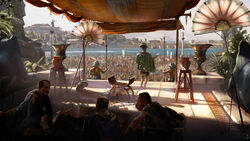
With Cleopatra finally present, Caesar chose to act as mediator between the silblings, in the hopes of a peaceful resolution.
It did not take long for things to sour. During a banquet given to celebrate the reconciliation, there was an assassination attempt on Caesar. It was the Roman leader's own barber who thwarted the attack.
Once it was revealed that the king's regent, Potheinos, had ordered the attack, Caesar had him executed. He then placed the young king under guard.
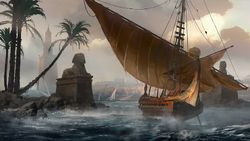
Caught within the palace with roughly 4000 troops and with the knowledge that the arrival of enemy forces was imminent, Caesar sent for help from Syria, Rhodes and Cilicia.
he ordered his men to dig a ditch around the palace and build a wall leading to the harbor. This would ensure Caesar's access to the sea.
When Egyptian general Achillas arrived in the city with 20 000 men, the battle for Alexandria began.

With so few men at his disposal, Caesar could not risk a battle just yet. He sent ambassadors to Achillas, in the name of Ptolemy, to propose a truce.
Knowing that the orders did not come from the young king and angered by the pharaoh's imprisonment, Achillas had the messengers assassinated.
With Caesar confined within the palace, Achillas positioned his troops around the city. Skirmishes broke out throughout the streets of Alexandria, and went on for several days and nights.
Though they were outhumbered, Caesar's men were able to hold the enemy back. This prompted Achillas's next move: capture the Roman fleet stationed in the harbor.
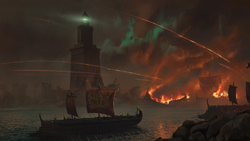
Although the palace offered protection, Losing the port meant the end of help and supplies. Caesar knew he had to protect the fleet.
While he and his troops succeeded in regaining control of the port, he knew it would be impossible to sustain.
Caesar ordered the burning of the ships. With passage back to the palace closed off, he headed for the Lighthouse of Alexandria.
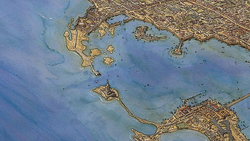
Fighting their way through the Egyptian troops, Caesar and his men eventually reached Pharos island. There they took refuge within the lighthouse.
With easy access to the open sea, Caesar was able to send messages to his allies requesting reinforcements and more supplies.
The island fort also allowed him to control access to the harbor by relying on the chains used by the Egyptians to control ship traffic to and from Alexandria's docks.
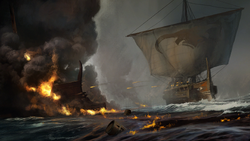
The exact chronology of events during the war in Alexandria remain imprecise. Conflicting accounts raise questions as to when, and even if, the Great Library of Alexandria was burned down at all.
One account states that during the fighting, docks and warehouses were burned and this was the fire that spread to the library.
In another account, when Achilias cut off the harbor, Caesar had to leave the safety of the palace to defend his ships. As the enemies battled across the port, their arsenals set ships ablaze and this destruction spread to the library.
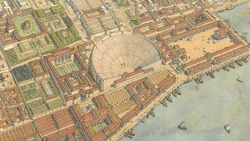
In either case, the Great Library was not completely destroyed. Experts point out that its location was too far from the harbor, and much later texts refer to the Great Library as being intact.
Warehouses near the harbor contained manuscript copies awaiting export, and itis more likely that these documents were destroyed, than the Great Library.
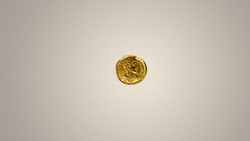
The destruction of the Great Library may have been due to a number of fires over the ages. Its end was probably closer to the 4th century CE when the Christian Emperor Theodosius I ordered the closure of all pagan temples.
While some documents survived after being moved away, it remains unclear just what knowledge may have been lost.
Where there are accounts of Achillas being in control of the battle against Caesar, it appears that instead Cleopatra's sister, siding with her brother, had him killed and put her ally Ganymedes in his place. Ganymedes proved a valuable tactician for the Egyptian side. It was his idea to cut Caesar's access to the harbor thus trapping Caesar at the palace.
During the time of Ptolemy I, canals had been dug throughout Alexandria to provide fresh water. Ganymedes had his men take control of these canals. After isolating their own water supply, he had his men pour salt water into the canals and cisterns that lead to Caesar's camp.

Panic erupted in Caesar's men. They wouldn't last long without fresh water. Recognizing that the porous limestone could help them, Caesar and his men dug wells to restore their water supply.
Days later, the 37th Legion, comprised of Pompey's soldiers, arrived by ship. Unable to come ashore due to the winds, Caesar risked going out to meet them on the peninsula, Cape Chersonese.
When the enemy learned Caesar's location, they rushed to intercept.
Despite an obvious advantage for the Alexandrians, Caesar, with a Rhodian ship full of skillful sailors, emerged victorious.
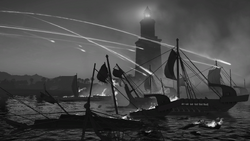
With help from the allied ships, Caesar's victory enabled him to push the Egyptians back and secure the Lighthouse.
Gaining control of Pharos island sent the Alexandrians into the sea and swimming back to the city.
However, Caesar's fortification of the island didn't last long.
The enemy regrouped and were set to storm the island.
Panic-stricken, in spite of Caesar's encouragement, many of his men then fled their posts either by ship or jumping into the sea.

Caesar attempted to retreat, but Port Eunostos' harbor was overrun with enemy ships preventing escape.
Reportedly, Caesar gathered his papers and leapt overboard in an attempt to swim to an allied ship farther out.
Historian Cassius Dio claimed that Caesar would've drowned if he hadn't been able to remove his purple garment. Still, he managed to swim the distance and survive.
The Alexandrians recovered the cloak and used it as a trophy to commemorate the Roman debacle.
Unhappy with Ganymedes and wanting their king restored, the Alexandrians approached Caesar with a compromise. Caesar agreed to release Ptolemy XIII, after entreating him to spare the kingdom and remain loyal to Rome. Once freed, however, the king defied the agreement and continued the war.
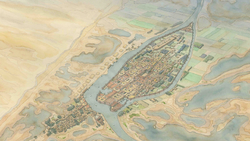
By this time, a faithful ally of Caesar's, Mithridates, arrived in Egypt, clashing with Ptolemy's troops at Pelusium.
Outnumbering the enemy, Mithridates secured the region between Pelusium and Alexandria.
Ptolemy, warned of Caesar's ally marching on Alexandria, sent his troops to prevent passage over the river.
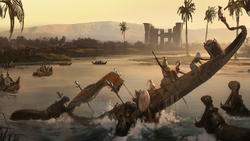
Mithridates warned Caesar in time, and the two groups confronted the armies of Ptolemy in the Delta.
In the Battle of the Nile, the Romans gained the upper hand, sending the Egyptians fleeing.
In the tumult and panic, King Ptolemy XIII drowned in the Nile.
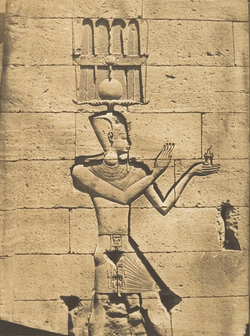
After the siege ended, Cleopatra VIl married her younger brother, Ptolemy XIV, enabling her to reign over Egypt until 30 BCE.
Under her rule, Alexandria settled into its position within the Roman Empire, and eventually surpassed Athens as one of the most important cities in the Roman Empire.
Julius Caesar remained in Egypt for a short time. He and Cleopatra would later have a son, named Caesarion.